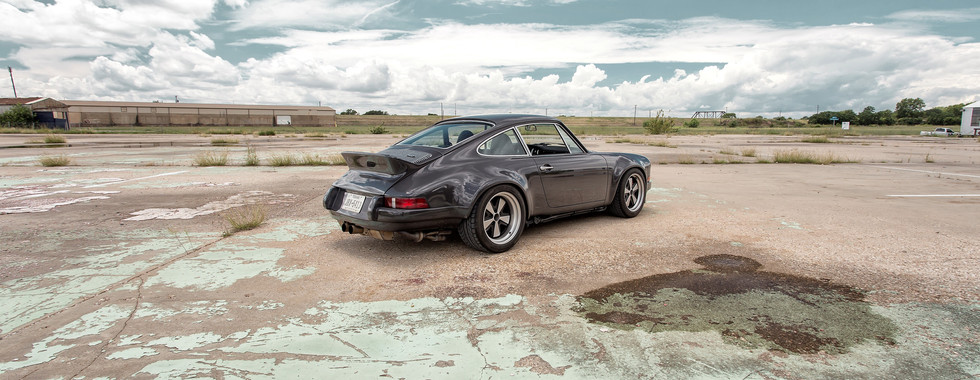They were wrong. There is only one shade of grey.
- Editor
- Nov 17, 2019
- 7 min read
Updated: Jan 7, 2020


Being that this is a collection of words concerning a 911, and being that the 911 has been in production since September 1964, there are a few tropes that we should go ahead and get out of the way immediately. The majority of these must, by some immutable force of automotive writing, be dealt with in anything written about all Porsches, and doubly so for the 911. So, for the benefit of you, the reader, and particularly myself, let’s address them so we can get on with it:
The 911 is rear-engined. I’m supposed to say how that’s wrong or different or what challenges they’ve faced over the last ten US presidential administrations have been dealt with by some stroke of Teutonic brilliance.

The 911 has been a successful race car. Any HPDE, any SCCA event, any NASA event, any track event from Thailand to Temecula will always – always – have a Porsche or eighteen.
I’m generally supposed to lead with this, given the new crop out of Stuttgart, but there must be some formal indictment of modern Porsches. Usually, that must encompass: size, power, variety in the lineup with a specific disdain brought to the four-door offerings (while simultaneously complementing them for being best-in-segment), and of course water-cooling.
So, when I got a call to write something about a Porsche, I had a fairly decent idea about my marching orders. The car has been in production for 53 years, and these reviews have been coming out for 53 years, which means there are just so few words and phrases left to order to get across what driving one is like. Which means my encounter with this car should be an open and shut case. Should be.
The photographer on the other end of the line, however, was gushing praises about his experience sitting with a stiff clutch and manual steering going 2 miles per hour in a gully washer in Dallas North Tollway Friday rush hour traffic on his commute back home. I’m fluent in Porschespeak, it’s how their owners discuss with sacred reverence for The Good Days Before The 996. It’s their way of talking in tongues, and until you figure out chassis codes, it’ll sound an awful lot like they’re gingerly comparing area codes and are very passive-aggressive to the idea of coolant.

The car he was describing with Shakespearian hyperbole sans the iambic pentameter did not perhaps roll off the assembly line meriting such kind words. Somewhere buried in the VIN, this car is a standard 1991 911 Coupe, an exercise in engineering overkill which ushered in a decade of ever direr financial straits at Porsche headquarters.
And yet.
I’m delighted to report that the tropes will not carry this piece across the finish line: we’re going to have to cover some new territory.

An ordinary 1991 Porsche 911 tends to stand out in modern traffic. The dimensions on the old air-cooled chassis are compact, taut, and impossible with today’s pedestrian and passenger safety requirements. This has always been the hidden key to how these stay so timeless – the proportions are conservative and always built on the prior generation without ripping too far ahead of the style of the times. Porsche has always let the 911 be the black suit of their lineup: same tailor, different cut.
If you were ever on the fence regarding the entire practice of turning back the clock on the later 911SCs or 964s, this car makes a bulletproof case. Put together by some collection of mad geniuses at Rothsport Motorsports nestled in the Willamette Valley, this 1991 example has been back-dated to 1973 Carrera steel widebody panels with a set of carbon fiber bumpers and a carbon fiber hood. The sleek, pre-Milli Vanilli-era body panels and tidy trim have an opportunity to grace a more modern chassis. It’s downright imposing from the profile and rear three-quarters view – Porsche mastered the fender flares back in the early 70s, and with the chin mounted oil cooler and ducktail, it's just the right amount of superfluous. The 275 section rear tires protrude from the fenders and are half exposed when you’re following the car, just exuding that race car cool in a James Hunt kind of way.

Observing how the masses interact with it around downtown Fort Worth, the car draws a certain kind of attention. Folks might not know what a 911 is, nor would they even have to know what a Porsche is, but if you asked them to sit back in study hall and draw a sports car, this is the shape they’d likely come up with. It’s not the nuclear yellow Aventador sort of experience, though. Nobody runs up with camera phones on quick draw and nobody asks you what you do for a living. But you can tell they know it’s something different – something that’s hard to place in time, classical in shape. They know it’s special, even if they can’t put their finger on it.
Driving it, however, there is no insinuation of that je ne sais quois. Not once, not ever.
At idle, the car has lope – not the Kennedale 1/8th mile Friday night Midnight Madness sort of lope, but the paddock at Sebring in 1973 sort of lope. It’s got that idle that isn’t wake the neighbors up loud, but you can tell once you get into the rev range, it gets operatic. The first time you start it and let it set down to warm idle, you’ll catch the clutch chatter that’s been a successful carryover all the way into the new 911R.

The clutch is somewhere between firm and heavy – I think I’d settle on deliberate. Shifter actuation is pleasant enough I’ve got a tab open on the development of the G50 transaxle to see if there’s anyone around in that department to whom I can send an Edible Arrangement. With a flywheel that’s on the superleggera that makes for explosive on the blips between downshifts, you need a shifter you can count on. And dammit if this isn’t the one and only.

Taking off, low speeds are, well, docile. Manual steering rack in the car isn’t nearly as fast as the new stuff, but far lighter than most manual racks. In a car that’s been brought together as well as this, this is exactly what you’d want. It’s light enough to remind you that the weight is behind you. This car has no business being this simple to daily drive – clutch chatter and lope and enough backseat to get luggage for the weekend or groceries or Nomex and a breaker bar for the lug nuts on the five-spoke Braid wheels is an awfully sinister combination.

This car also has an engine, which, as it turns out, is not bad in the sense that everything else that you’ve ever driven is a lesser form of movement by a wild margin. It’s not the tear-you-a-two-bedroom-one-and-a-half-bathroom-double-wide-hole in your understanding of acceleration rocket ship stupidity that 997 and 991 Turbos tend to hit you with. Nor is it the just-the-scientifically-correct-amount-of-torque-to-match-PDK-on-Sport-Plus-mode from the Caymans. No, this is something else.
Taking the tach through the midrange and all the way to redline is an on-demand performance of Porsche’s magnum opus. It will provoke a spiritual journey starting at the very formation of the universe, how it came to be governed by the laws of physics, which, in their infinite mystery and playful tease with the human condition could possibly, in just a half-century of Germanic obsession to the point of fiscal ruin, be so carelessly and casually tossed aside by some wizards in wine country Oregon. The way this engine pulls from 5,000RPM all the way to the redline at 8,000 produces a forceful incongruity of both complete contentment while contemporaneously being overwhelmed with a newfound addiction to keep running it up and down the rev range until the mountains crumble back into the sea. Nearing redline, this thing makes the kind of noise that could jump start existence following the entropic heat-death of the universe.
To reiterate – this motor is quite not bad.

This car under anything past half-throttle has a sound that you can feel resonating off the banking at Daytona at 3AM right after Hurley Haywood turned it over on a double stint with a fresh tank and 4 new slicks.
It’s got that dual-nature Porsche feeling of being completely bulletproof in execution and yet completely unhinged when you want it. It’ll go full murder-death-kill, but only when you ask politely.
The suspension, Bilstein PSS10s at all four corners, has dampening so well suited to the car it’s uncanny. You’d be just as happy to hop in the car at the Red Ball Garage, run the Cannonball, fill the car back up with gas, and put in a few sessions at Buttonwillow with nothing more than a set of fireproof socks and a helmet. The steering at speed loads up like a manual rack should – something that Porsche has been getting away from, first with hydraulic and then electric assists, and all the while trying to emulate what they had 30 years ago. And maybe that’s the key to this car’s allure.
Back when we were kids, we used to wonder what it’d be like if Kobe could ball with Jordan, or if Sandy Koufax could have dueled with Barry Bonds at the height of the steroid era, or if Ronnie Lott could’ve duked it out in the backfield with Julio Jones. You could create this all-star-of-all-time team. And looking at the spec sheet, this car is just that, with parts from the 911, 964, 996, and 997 chassis. This owner has picked the best bodywork right off the RSR 911s with the 2.7RS ducktail, while putting down 991 levels of power from a 4.0 liter naturally-aspirated air-cooled engine, with ABS and power windows and A/C that works and a great stereo and all-day-every-day practicality and reliability.

It’s wrapped up in a package that just aches to be driven. And that’s a serious risk with the air-cooled market. It’s not difficult to see why these get snapped up into collections, commissioned to be borderline static industrial art installations, moving only under their own power to head to Cars and Coffee or get shipped to Monterrey for a week a year. It’s the Fred Astaire Paradox: nobody drives a Singer in the rain. Fortunately, this car arrived fresh from an HPDE, a week of commuting, in the rain, Texas sun, and half a dozen photo sessions and it didn’t skip a beat. This car gets mileage and that’s a Damn Good Thing.
Between you and me, I don’t see why anyone else does anything different if they’ve got the coin and the taste to make one of these happen in their life. It’s just so good and it’s just so good all the time. No, the tropes won’t help here. The 911 is rear-engined because of course it is. It’s a good race car because of course it is. And Porsche still makes good cars – but never anything quite as electrifying as the air-cooled era..
If you’re anything like me, you’re always searching through the classifieds and the forums and the dregs of Southern California Craigslist to see just what’s out there and what you might see yourself in one day. You can stop that nonsense now. The answer you’re looking for is a battleship gray back-dated 964 with RSR bodywork on deep-dish five spokes with a motor conjured from the fires of Valhalla.
Always was, always will be.
Coolant is for suckers anyway.



































Comments